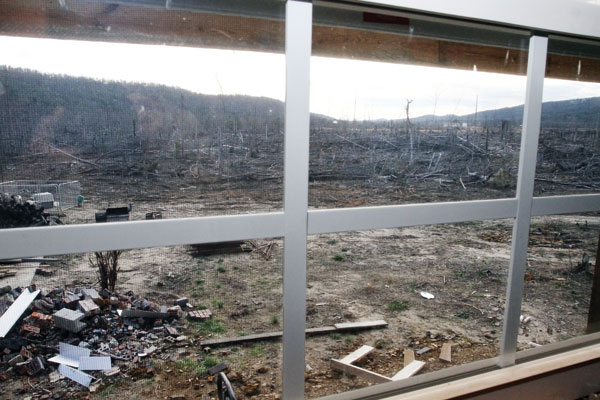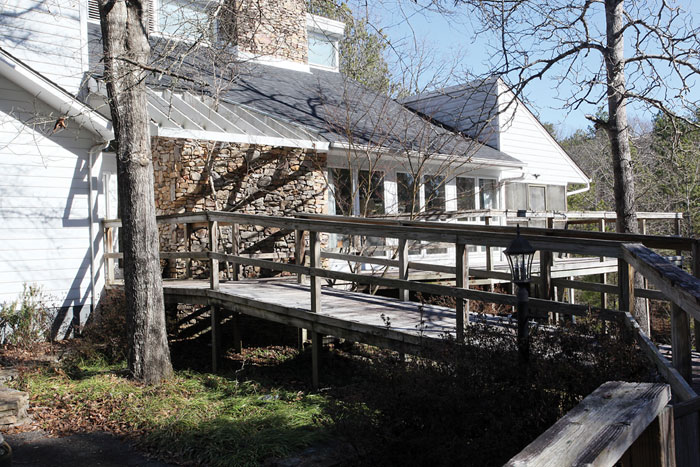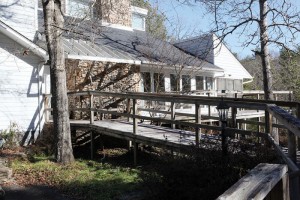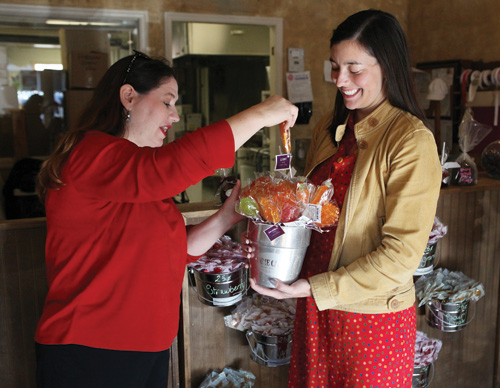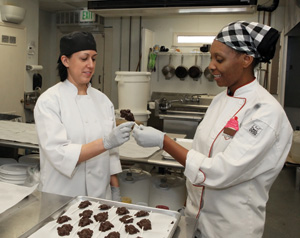Tragedy, triumphs mark life in the valley
Story by Carol Pappas
Photos by Jerry Martin
Folks around Shoal Creek Valley have said it often enough over the past 12 months — “getting back to normal.”
But in this St. Clair County valley, normal has a new meaning since a tornado’s fury swept all the way through it, shattering homes and destroying lives in its path.
 Tears find their own trail down Buford Sanders’ weathered face. With a determined gaze, he raises a single finger and vows this will be the last time he tells his own story of loss. “It’s time to look forward, not back.”
Tears find their own trail down Buford Sanders’ weathered face. With a determined gaze, he raises a single finger and vows this will be the last time he tells his own story of loss. “It’s time to look forward, not back.”
As he recounts the details of April 27, 2011, it is with the freshness of a memory made — not a year — but a moment ago. “It was 6:30 p.m. We saw it was coming. We lived at the top of the hill. My wife and I had no place safe to go, so we simply hunkered down in the middle of the house.”
The storm first hit the west end of his house overlooking Shoal Creek Road, blowing away a room, a porch and the roof. “It came back and blew off the east end,” he said. All that was left was a sturdy piece of wall where the couple crouched.
“We were thinking everything was OK,” Sanders said. The house had been lost, but they were safe. Just then, two of their grandchildren were “coming up the hill, hollering and crying that they needed help.”
The flow of tears comes in waves from this point as he tells what happened next. His son and daughter-in-law and one of their daughters had been blown 75 yards from their home into a blueberry patch.
The death of his daughter-in-law, Angie, came quickly. His son, Albert, lasted three or four hours. “He told me he thought he was going to die. I told him, ‘No, son, I love you too much.’
“ ‘I love you, too, Daddy,’ he told me, and those were his last words. It was just a matter of time, and he was gone.”
During Albert’s final hours, all Sanders could do was keep his son comfortable. No medical help was able to get there because the tornado so devastated the valley that it was virtually blocked from one end to the other. “We could hear the chainsaws running in both directions,” he said.
The Sanders family were like many in Shoal Creek Valley. They lived near one another; their generational ties strong. “We worked on things together,” he said of his son, Albert. “He was my buddy. It was sad his life came to an end.”
Buford Sanders and his sons raised their families on the same property, a single driveway leading to all three homes. In an instant, all three homes were swept away.
His other son had been thrown from his home by the winds, but he recovered and is doing well, his father said. His granddaughter, Cassie, spent five weeks in the hospital undergoing 12 to 15 surgeries and has little memory of what happened in the hours and weeks that followed the storm.
 She used to be a runner. “She loved to run,” Sanders said. “She ran track. We had a track for her around the hay field.” Her recovery since April 27 has been painful and slow, but she is beginning to run again, entering 5K races, a proud grandfather noted, underscoring her resiliency.
She used to be a runner. “She loved to run,” Sanders said. “She ran track. We had a track for her around the hay field.” Her recovery since April 27 has been painful and slow, but she is beginning to run again, entering 5K races, a proud grandfather noted, underscoring her resiliency.
He, too, is beginning to return to some semblance of routine. He and his wife have been back in their new home for about six months, he said. “If I just lost the house, I could feel good.
“But every step I take, I see the tragedy.” Just outside his back door still lay hundreds of acres of downed trees across the mountainside, a constant reminder of a storm so mighty and strong it could wipe out a forest and kill a dozen people in a matter of moments. “If it had just left all my family intact, I’d be the happiest man on earth.”
Just before the storm hit, he said he called both of his sons and told them to go to their safe places. “They did what I asked them to, but it wasn’t good enough.”
Sanders’ conversation vacillates between past and future. “The hurt of losing some of your blood is bad,” he said. “But the community and I are looking forward and looking ahead, not back. You have to suck it up and say this is the way it is. Keep going,” he said.
“So many people befriended us. They helped cleaning up. It was dangerous even to walk around. You lean on one another in times like that. So many people were so good to us.
“A fella I had never known built those kitchen cabinets,” he said, pointing across the room to what could only be described as the intricate work of a master craftsman. “When I went to pay him, he didn’t charge me. Things like that. A lot of people I had never seen before came and helped. I made lifelong friends. I’m grateful for that.”
Looking to the future, he said, “I guess from now on it will get somewhat better. It will be a long time. I have a strong little wife. We’re Christian people. We believe the Lord will take care of us through the battle and there will be a reward at the end.”
He shares a special kinship with the community that has suffered so much. The community came together “in mind and spirit” through the storm and the months of a painful aftermath, he said.
But the lesson from all of this, he said, lies not in the homes destroyed nor does it dwell in the material possessions snatched away by a greedy gust of wind. “The tragedy of all this is the lives that were lost in the twinkling of an eye.
“I would have loved to have swapped places.” Albert was 44. Angie was 43, and they had three daughters. “They had a lot to look forward to.”
Now it is up to Sanders to look forward, he said. “The important thing is the lives that were lost in this valley. The devastation of property is bad, but the other things are a lot worse.
“We have to look forward. You know, onward, Christian soldiers.”
• For more on Shoal Creek, read Building for the future amid remembrances of past and Pell City engineering firm rebuilds after direct hit in this month’s edition of Discover, The Essence of St. Clair Magazine.











